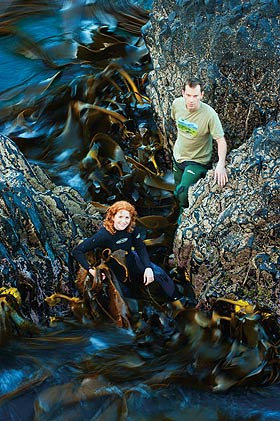
 Dr Ceridwen Fraser and Associate Professor Jon Waters:
Dr Ceridwen Fraser and Associate Professor Jon Waters:
They have shown that common bull kelp is being used as an ocean “raft” by a wide variety of marine organisms.
An evening stroll along one of Dunedin's most popular beaches has led to a fascinating discovery by Department of Zoology researchers. They have found that the large and distinctive bull kelp which frequently washes up on New Zealand shores is playing a critical role in biodiversity and the distribution of many marine plants and animals.
The study, led by Associate Professor Jon Waters, used genetic evidence to ascertain for the first time where bull kelp plants washed up at St Clair Beach, Dunedin, had come from.
The researchers found that several of the kelp specimens had travelled from the sub-Antarctic, some from as far away as the Auckland Islands, 600 kilometres south of New Zealand, and the Snares Islands, 390 kilometres south of the mainland. These ocean voyages are estimated to have taken several weeks and, in some cases, over two months.
Postdoctoral researcher Dr Ceridwen Fraser, who co-authored the study, says the kelp's strong buoyancy and toughness made it able to withstand long periods adrift in the ocean.
“We see a lot of bull kelp drifting out at sea and scientists have always suspected that it could travel a long way, perhaps even crossing entire oceans. Now we know that it really can,” Fraser says.
Kelp anchors itself to the sea floor with a hollow, root-like structure – or holdfast – that is also home to many marine organisms. When the kelp breaks off and floats away, the organisms go with it.
A wide variety of rocky-shore animal species were shown to raft with the kelp by clinging on, or by living within burrows and crevices in the holdfast. These “hitch-hikers” included snails, sea stars, crustaceans and sea spiders.
Coastal species that live on small, isolated islands do not have many options when it comes to inter-continental travel. “We suspect that this type of rafting is an important means for many of these rocky-shore species to distribute themselves across oceans and around the isolated coasts of the Southern Hemisphere,” Waters says.
Although it had previously been suggested that long-distance rafting might be possible, “this is the first study to show that such a wide variety of different species can actually raft across oceans and arrive at distant shores”.
In coastal Otago, large amounts of drifting seaweed are regularly washed ashore during easterly weather systems. Bull kelp plants that have been drifting in the open ocean for a long time often have large, stalked goose barnacles growing on them and it is the size of these barnacles that can be used to estimate how long the kelp has been at sea.
Funding
- Marsden Fund